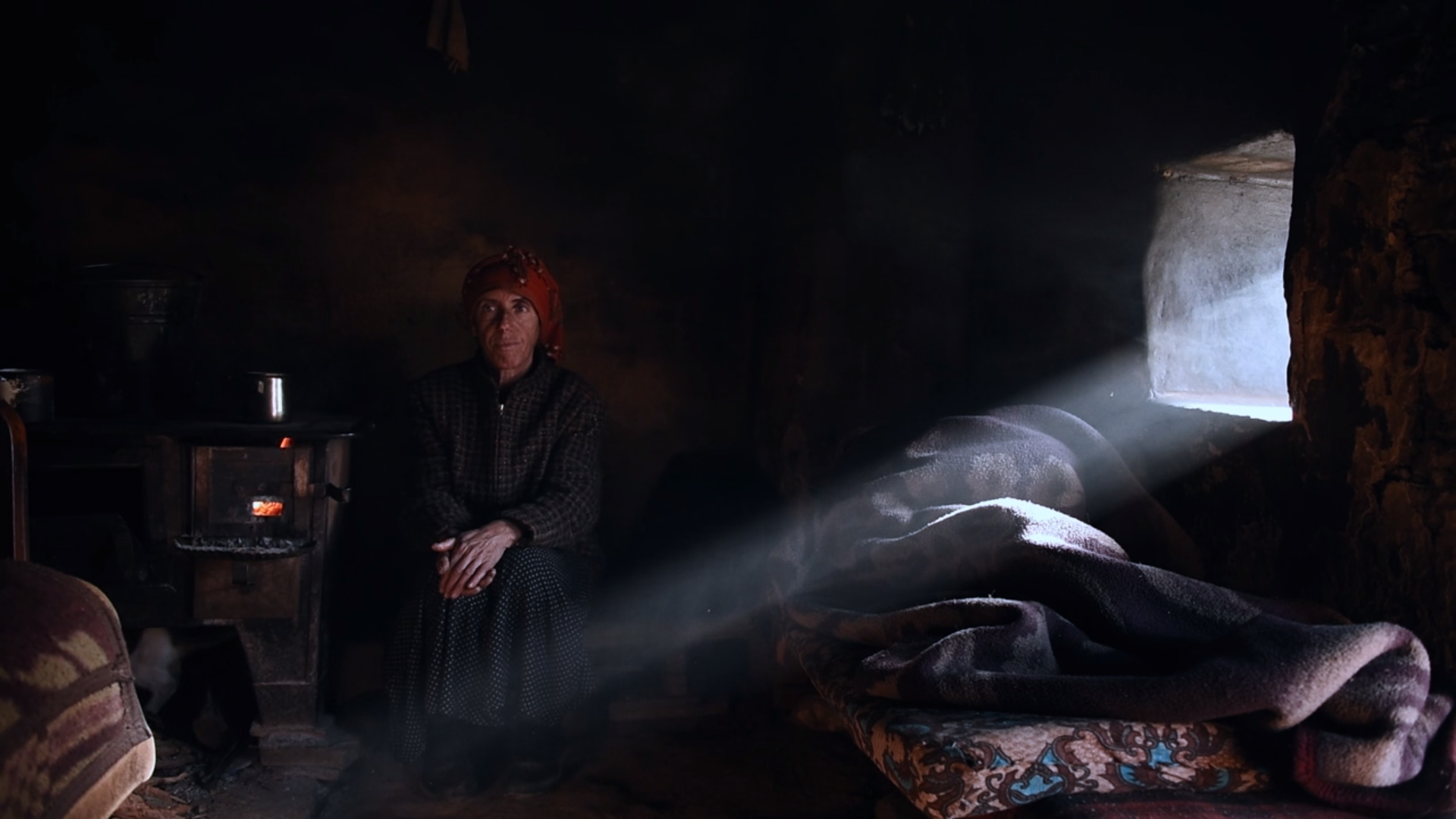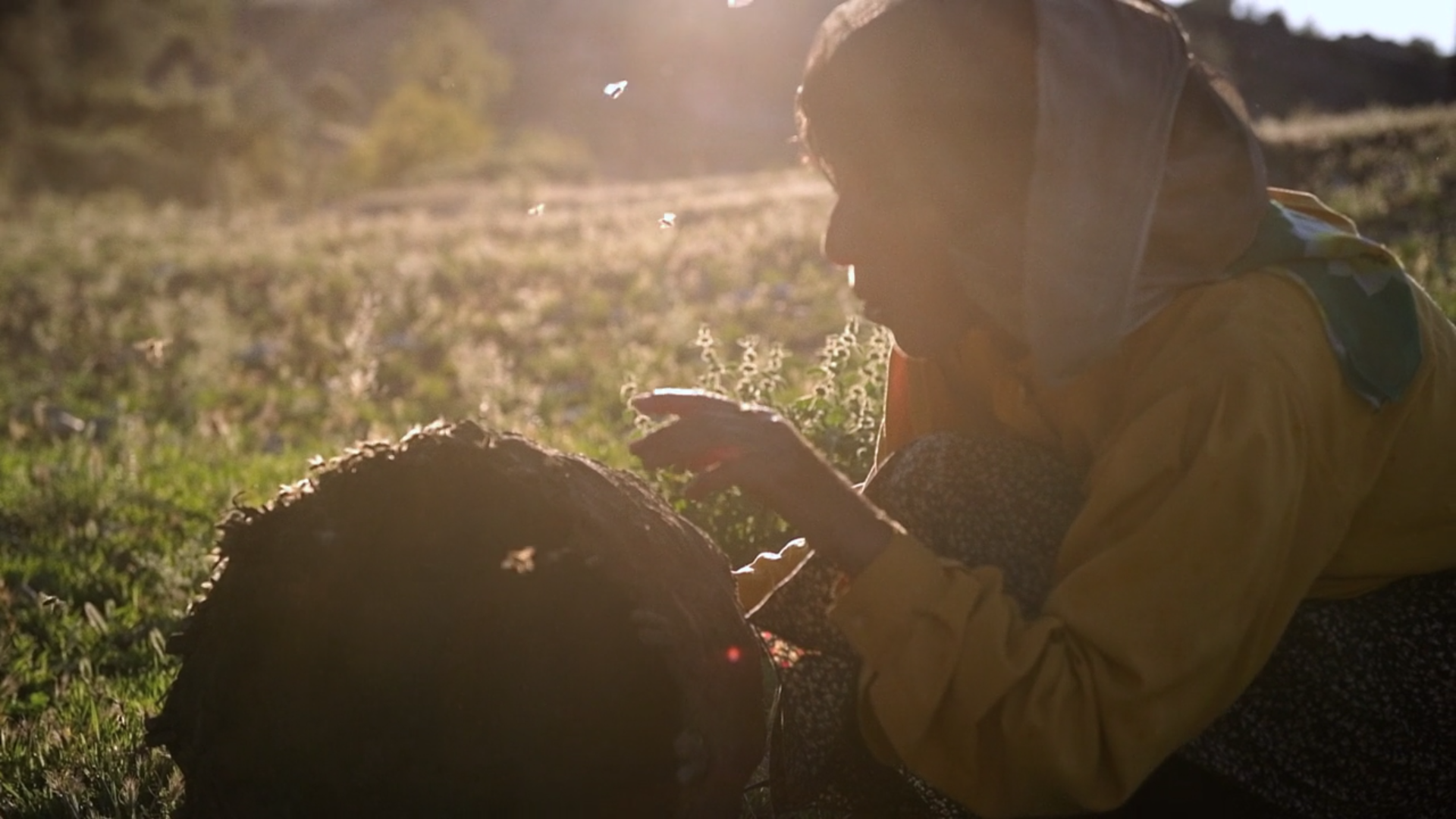Doc Talk: Caleb Allison on ‘Honeyland’
DocTalk is a series of critical reviews of contemporary documentaries by Media School graduate students.
Honeyland: A balancing act
Under soft candlelight in the dead of a harsh winter night, Hatidže asks her ill, bedridden mother, “Can you imagine spring coming?” Her mother replies with another question, “Is there spring?” The exchange comes toward the end of “Honeyland” (Tamara Kotevska and Ljubomir Stefanov, 2019), after a tragic encounter has left Hatidže Muratova and her aging mother, Nazife, in bleak circumstances that may very well overwhelm whatever emotional resolve you have tucked away for such cinematic occasions. The moment is absolutely crushing. Not only does it reveal Nazife’s declining health but a creeping hopelessness in their situation. Recalling the coming of spring while mired in the darkening depths of winter, Hatidže also subtly reveals a poignant theme infused throughout the film – that of balance.

Over the course of the documentary, we are witness to a dynamic, magnificent and often painful struggle for balance, fraught with the interminable conditions of existence: Winter gives way to spring, relationships form and fall apart, rules are created and broken, life is given and taken away. “Honeyland” exquisitely reveals this universal balance through the visually expansive and socially remote world of wild beekeeping in the mountains of Macedonia.
At the frontier of this balancing act, a battle is waged over the ethics of environmentalism and sustainability. Early in the film Hatidže’s approach to beekeeping is summed up neatly after she harvests a golden slab of honeycomb from one of her hives. She tenderly consoles the bees by leaving them half of their honeycomb. “One half for me, one half for you,” she says. Taking any more and offering any less would disrupt the delicate balance they’ve agreed upon for survival.
Hatidže lives a solitary and spartan life beekeeping in the remote mountain village of Bekirlija in North Macedonia, without running water, electricity or any apparent medical services. She periodically makes the 55-km trek to the bustling capital of Skopje to sell her honey and pick up supplies. Hatidže also attentively cares for her aging mother who lives with her, requiring constant attention, in part because of a festering medical condition. Life does not appear easy by any means, but Hatidže is an expert at wild beekeeping and clearly takes pride and pleasure in her work.
When the Sams, a large nomadic family of 10, show up, things take a turn for the worse. Act two is clearly afoot, and the filmmakers have shrewdly, or some might say deceptively, crafted a familiar narrative archetype of the horror, thriller and comedy genres – new and disruptive neighbors – à la “Rear Window” (1954), “Arlington Road” (1999), “The ‘Burbs” (1989), “Fright Night” (1985), etc. The film itself straddles and blurs the lines between documentary and fiction. In an interview Kotevska claims as much: “Our biggest challenge was to create a documentary that had the internal structure of fiction. Because this is really the future of cinema: Fiction that looks like documentaries and documentaries that look like fiction.”
This is not a novel approach to documentary, but it is an increasingly popular one. Kotevska and Stefanov draw upon elements of traditional narrative filmmaking, such as their emphasis on elegant compositions, which lends their film an exceedingly poetic pastoralism. The region’s natural beauty and desolation contribute to this element too, alongside long stretches of film devoid of any dialogue. Any voice-over or talking heads would have flown in the face of the film’s aesthetic approach. Hatidže also seems comfortable in front of the camera, not compelled to fill the silences that often surround her, allowing the camera’s presence in her world to feel unobtrusive and disavowed. Combined, these features paint Hatidže in heavenly light, a compassionate environmentalist struggling against the insatiable greed of modern society.

If Hatidže’s world is founded on benevolent environmentalism – in balance with nature, the Sams, with their large herd of cattle, clanking mobile home and wily lifestyle, appear to be an opposing force – out of balance with nature. Godfrey Reggio’s “Koyaanisqatsi” (1982) comes to mind here and would make a compelling thematic pairing with “Honeyland.” While it is easy to see the Sam family as environmental foil to Hatidže, and that is clearly how they are framed in the film, this reading obscures their own economic hardships and familial obligations. Although they severely disrupt the delicate balance Hatidže has established with her bees, jeopardizing her very livelihood, their own precarious situation should not be overlooked.
The relationship between Hatidže and the Sams does not begin with outright hostility, but neighborly goodwill. The two families initially share intimate and compassionate moments together: They laugh over brandy around a night fire and exchange pets. Hatidže even offers Hussein, the Sams’ patriarch, advice on his own more domesticated beekeeping operation before things go south. In a meaningful exchange between Hatidže and one of the Sams’ younger sons, he asks her why she doesn’t just leave this place. She pauses for a long, heavy moment and replies, “If I’d had a son like you, things would have been different. But I don’t.” Ultimately, the Sams’ beekeeping endeavor fails, shifting that delicate balance between nature and consumption, as well as between neighbors. Their relationship reaches a breaking point, and somewhat conveniently, the Sams, having tipped the scales in dramatic fashion, pack up their belongings and move along down the road. Their departure signals a narrative and ecological reconfiguration – we are back in balance, or so it seems.
The film’s powerful aesthetic approach and timely environmental message did not go critically unnoticed, as it became the most-awarded film at Sundance 2019 and received dual nominations at the Oscars for Best Documentary Feature and Best International Feature Film. However, the film has also been criticized for these very same features. Dina Iordanova criticized the filmmakers for romanticizing and exploiting the austere conditions of Hatidže’s circumstance for the sake of a poignant political message on sustainability. For Iordanova the film becomes a morality tale about environmentalism and sustainability that borders on preaching, without recognizing the numerous political and governmental shortfalls that have left the film’s subjects in such vulnerable circumstances to begin with.
The film sits somewhat uncomfortably between critical praise and ethical scrutiny. It is also here, in this perilous space, that the social documentarian is often perched. What role, responsibility even, do they have to their subjects? If I am drawn to the notion of balance in the film, I believe it is because it permeates and complicates every layer, even spilling off-screen into the relationship between filmmaker and subject, even after filming ended. With the film’s startling success, the filmmakers decided to financially support Hatidže and the Sams with some of their prize money, even going so far as to mediate subsequent legal disputes between them. Rather than cut ties with their subjects, the “Honeyland” crew became further entangled in their subject’s social, legal and financial circumstances.
If there is a line to be drawn between the film’s fictions and realities, it’s not a hard line in the sand, but a constantly shifting one, without a clear beginning or end. If the future of documentary film is destined to blur this line, as Kotevska claims, “Honeyland” reveals the consequences of such an approach, forcing both filmmakers and their subjects to grapple with the responsibilities and demands they have for one another. The proverbial fly on the wall has become the cash cow. The realities of documentary exploitation are not simply bound by the end of a film; they spill out into the world in complex, tangled ways. In this sense, the story isn’t over yet, not for Hatidže, the Sams, Kotevska, Stefanov or their crew. A delicate balancing act is taking place. “Honeyland” just reveals more than most the struggle it takes to see it.

